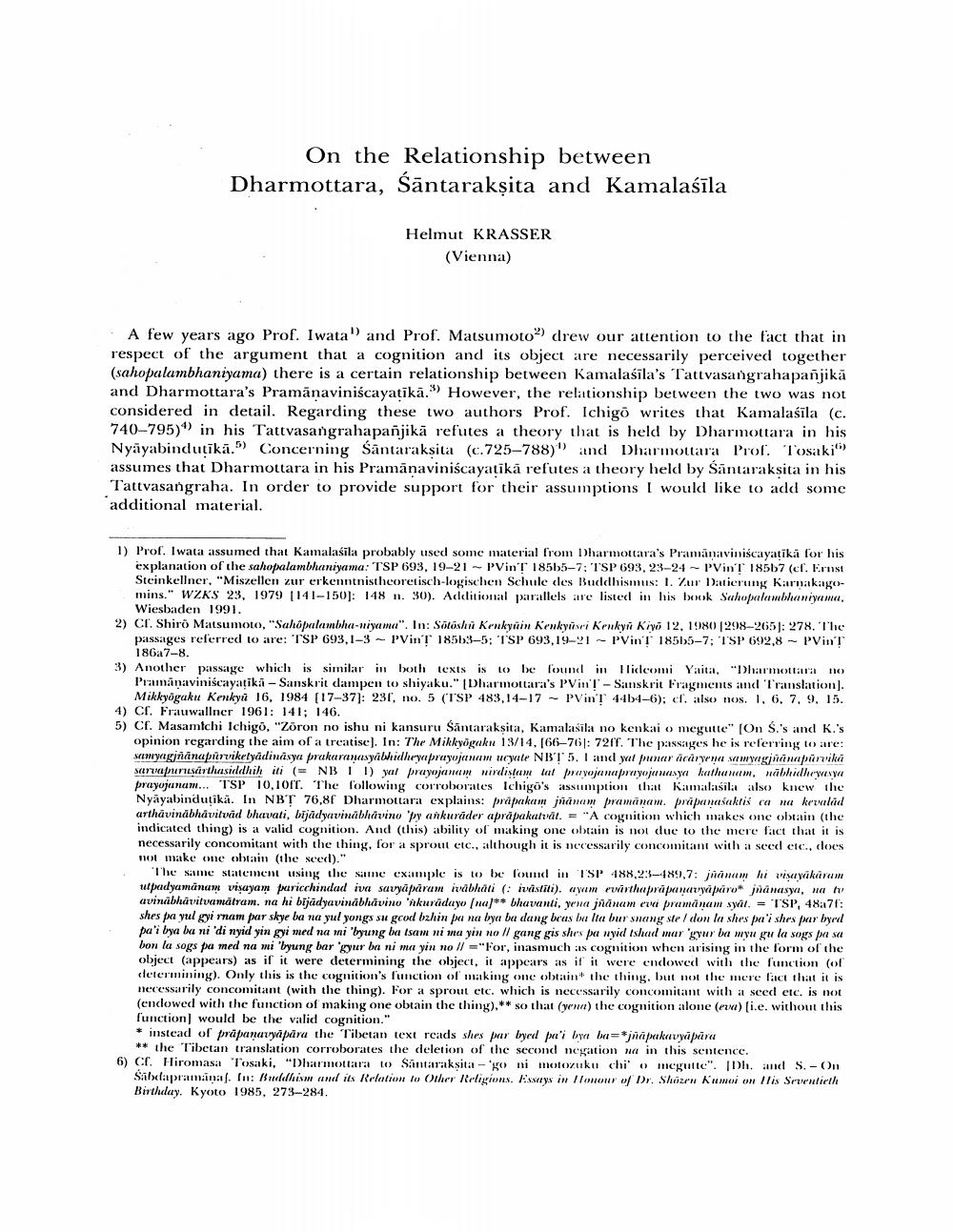Book Title: On Relationship Between Dharmottara Santaraksita And Kamalasila Author(s): Helmut Krasser Publisher: Helmut Krasser View full book textPage 1
________________ On the Relationship between Dharmottara, Santarakṣita and Kamalasila Helmut KRASSER (Vienna) A few years ago Prof. Iwata" and Prof. Matsumoto") drew our attention to the fact that in respect of the argument that a cognition and its object are necessarily perceived together (sahopalambhaniyama) there is a certain relationship between Kamalasila's Tattvasangrahapanjikā and Dharmottara's Pramāṇaviniścayaṭīkā." However, the relationship between the two was not considered in detail. Regarding these two authors Prof. Ichigo writes that Kamalaśīla (c. 740-795) in his Tattvasangrahapañjikā refutes a theory that is held by Dharmottara in his Nyayabinduṭīkā." Concerning Santarakṣita (c.725-788) and Dharmottara Prof. Tosaki assumes that Dharmottara in his Pramanaviniścayatīkā refutes a theory held by Śantarakṣita in his Tattvasangraha. In order to provide support for their assumptions I would like to add some additional material. 1) Prof. Iwata assumed that Kamalasila probably used some material from Dharmottara's Pramanaviniscayatika for his explanation of the sahopalambhaniyama: TSP 693, 19-21 PVinT 185b5-7: TSP 693, 23-24 PVinT 185b7 (cf. Ernst Steinkellner, "Miszellen zur erkenntnistheoretisch-logischen Schule des Buddhismus: 1. Zur Datierung Karnakagomins." WZKS 23, 1979 [141-150]: 148 n. 30). Additional parallels are listed in his book Sahopalambhaniyama, Wiesbaden 1991. 2) Cf. Shiro Matsumoto, "Sahopalambha-niyama". In: Sōtōshi Kenkyuin Kenkyusei Kenkyu Kiyo 12, 1980 [298-265]: 278. The passages referred to are: TSP 693,1-3 PVinT 185b3-5; TSP 693,19-21 PVinT 185b5-7; TSP 692,8 PVinT 186a7-8. 3) Another passage which is similar in both texts is to be found in Hideomi Yaita, "Dharmottara no Pramanaviniscayaṭīkā - Sanskrit dampen to shiyaku." [Dharmottara's PVin'T- Sanskrit Fragments and Translation]. Mikkyōgaku Kenkyu 16, 1984 [17-37]: 231, no. 5 (TSP 483,14-17 PVinȚ 44b4-6); cf. also nos. 1, 6, 7, 9, 15. 4) Cf. Frauwallner 1961: 141; 146. 5) Cf. Masamichi Ichigo, "Zoron no ishu ni kansuru Santarakṣita, Kamalasila no kenkai o megutte" [On S.'s and K.'s opinion regarding the aim of a treatise]. In: The Mikkyögaku 13/14, [66-761: 72ff. The passages he is referring to are: samyagjñānaparviketyädinasya prakaranasyabhidheyaprayojanam ucyate NBT 5. 1 and yat punar acaryena samyagjñānapūrvikā sarvapurusarthasiddhih iti (= NB II) yat prayojanam nirdistam tat prayojanaprayojanasya kathanam, nabhidheyasya prayojanam... TSP 10,10ff. The following corroborates Ichigo's assumption that Kamalasila also knew the Nyayabinduțika. In NBT 76,8f Dharmottara explains: prapakam jnanam pramanam. prapanasaktis ca na kevalad arthāvinābhävitvad bhavati, bijādyavinābhavino 'py ankuräder aprapakatvät. = "A cognition which makes one obtain (the indicated thing) is a valid cognition. And (this) ability of making one obtain is not due to the mere fact that it is necessarily concomitant with the thing, for a sprout etc., although it is necessarily concomitant with a seed etc., does not make one obtain (the seed)." = The same statement using the same example is to be found in TSP 488,23-489,7: jüanam hi viṣayākāram utpadyamanan visayam paricchindad iva savyāpāram iväbhāti (: ivāstīti). ayam evarthaprapanavyāpāro jñanasya, na to avinabhävitvamätram. na hi bijadyavinābhāvino 'nkuradayo [nal** bhavanti, yena jñānam eva pramanam syat. TSP, 48a7f: shes pa yul gyi rnam par skye ba na yul yongs su gcod bzhin pa na bya ba dang beas ba lta bur snang ste / don la shes pa'i shes par byed pa'i bya ba ni 'di nyid yin gyi med na mi 'byung ba tsam ni ma yin no ll gang gis shes pa nyid tshad mar gyur ba myu gu la sogs pa sa bon la sogs pa med na mi 'byung bar 'gyur ba ni ma yin no I="For, inasmuch as cognition when arising in the form of the object (appears) as if it were determining the object, it appears as if it were endowed with the function (of determining). Only this is the cognition's function of making one obtain the thing, but not the mere fact that it is necessarily concomitant (with the thing). For a sprout etc. which is necessarily concomitant with a seed etc. is not (endowed with the function of making one obtain the thing),** so that (yena) the cognition alone (eva) [i.e. without this function] would be the valid cognition." * instead of präpanavyāpāra the Tibetan text reads shes par byed pa'i bya ba=*jñāpakavyāpāra **the Tibetan translation corroborates the deletion of the second negation na in this sentence. 6) Cf. Hiromasa Tosaki, "Dharmottara to Santarakṣita-go ni motozuku chi' o megutte". Dh. and S. - On Sabdapramanaf. In: Buddhism and its Relation to Other Religions. Essays in Honour of Dr. Shazen Kumoi on His Seventieth Birthday. Kyoto 1985, 273-284.Page Navigation
1 2 3 4 5 6 7 8
